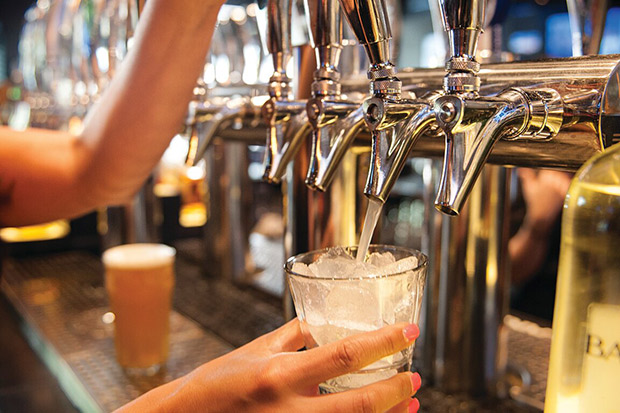As foodservice operators continue to seek effective solutions in combating the rising costs of overhead, labor and food, many are incorporating batch cocktails into their beverage programs. Not only does this greatly enhance efficiency and consistency while also diversifying menus, but it also significantly reduces labor needs for creating these drinks, leading to higher margins.
With restaurants and bars increasing their number of open draft lines 47% in recent years, according to industry beer line management leader Draftline Technologies, the extra tap space and popularity of spirits proves there are lucrative opportunities for operators to add batch cocktails to the menu.
Benefits of Cocktails On Tap
In addition to added profits and increased efficiency, there are a number of other benefits for operators serving cocktails on tap. These include consistency with added speed; the ability to provide drink samples to customers; minimal waste since cocktails are made correctly every time; and less pressure on bartenders, who are simply pouring rather than measuring and mixing each time.

For patrons, cocktails on tap provide added convenience since there is no wait for drink preparations. Also, because customers can sample cocktails before buying, they won’t waste their money on a beverage they don’t like. And because cocktails on tap are produced in bulk with exact measurements every time, these drinks are more consistent.
Essential Equipment for Your Kegged Cocktail Program
To ensure the best beverage quality and consistency of pour, it’s important to incorporate the proper equipment that will ensure a batch cocktail program is a success.
Beverage flavor and consistency are dependent on using 304-grade stainless steel equipment and components, high-grade Barriermaster beverage tubing and a high-quality mixing system.

It’s important to note that hardware material will impact cocktail quality. Using plated brass or lower-grade stainless steel components can result in a metallic off-taste. With 304-grade stainless steel, not only is corrosion not an issue, but unwanted reactions with beverages is prevented.
Like stainless steel grades, the type of tubing used in draft systems impacts batch cocktails’ flavor. Because beer systems’ vinyl or polyethylene tubing has high permeation rates, beverages can become oxidized from the tubing’s air ingress. With one of the lowest permeation rates of any beverage line in the industry, Barriermaster Flavourlock™ beverage tubing allows operators to change out cocktails easily while keeping the quality and flavor intact and consistent.
Consistency is key when creating batch cocktails, but the complexity of ingredients can make this challenging. This is why continuous mixing utilizing SpinStick™ technology prevents ingredients from settling or separating by continuously mixing beverages. To use, operators simply drop the SpinStick™ stirrer into a 9L or 18L reusable Beverage Tank with their batch recipe, then place the tank on top of its proprietary motor base. Cocktails are then quickly yet gently stirred continuously for the ideal results every time.

While non-carbonated beverages require food-grade nitrogen applied to the Beverage Tank, carbonated cocktails, which have experienced a resurgence recently, require 100% CO2 when in a short direct draw system like a kegerator. The quantity of gas needs to be just right to preserve the proper amount of effervescence for the whole batch. With remote or long draw draft systems, a blend of CO2 and nitrogen may be needed.
Batching and Cocktail Recipes Best Practices
There are endless recipe ideas that can help inspire a creative and profitable batch cocktail program. For inspiration and signature cocktail ideas that will set your menu apart, operators can work with beverage program developers such as Straight Up Collective.
There are a number of batch cocktail recipes that are menu staples. One of the most popular cocktail in North America currently is the Spicy Margarita. A batch recipe combines 37.5 ounces of jalapeno tequila, 12.5 ounces of triple sec, 50 ounces of sour mix, 6.25 ounces of elderflower liqueur and 18.75 ounces of filtered water for dilution.
The Classic Old Fashioned, a staple whisky cocktail that has seen increased popularity, combines 51 ounces of bourbon whiskey, 51 ounces of rye whiskey, 12.75 ounces of orange liqueur, 38.25 ounces of old fashioned syrup and 25.5 ounces of filtered water for dilution with bitters added at the end.
It should be noted that drink dilution with filtered water is critical to recipe science and in creating the perfect batch cocktail. Dilution ranges from 10% to 12% for stirred cocktails and 15% to 20% for shaken cocktails.
Having the proper tools not only simplifies the batch cocktail creation process but also ensures speed of service and consistency. Items like beakers for measuring liquids, scales for weighting ingredients, a strainer for keeping out pulp and the like, along with a whisk, silicone measuring cup and funnel, are among the essential items needed for a batch cocktail program.
Proper cleaning of equipment and supplies with the appropriate solutions is critical to not only making sure everything is kept in tip top shape, but also to retain the integrity of the beverages being made.
How Cocktails on Tap Have Transformed The Drinking Experience/Summary
Cocktails on tap have increased beverage programs’ efficiency, speed of service and consistency, while significantly saving on labor and costs.
Micro Matic is your batch cocktail solutions provider, offering expertise and guidance on the equipment you need to jump start a successful program and transform your business and beverage offerings.




